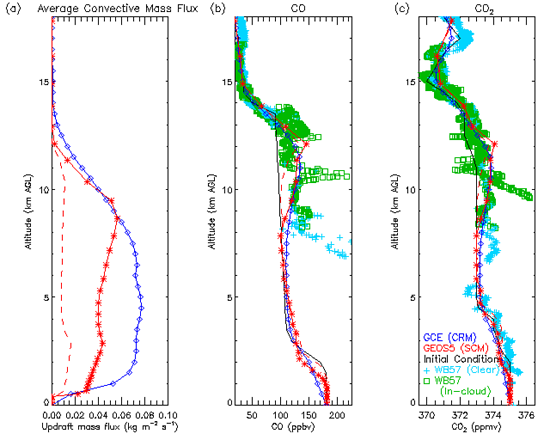|
Lesley Ott, Julio Bacmeister, Steven Pawson, Ken Pickering, Georgiy Stenchikov, Max Suarez, Heidi Huntreiser, Max Loewenstein, Jimena Lopez, Irene Xueref-Remy
Begin Main Content
Updrafts which occur in thunderstorms affect the chemical composition of the atmosphere by transporting gases emitted near the earth's surface upward where they have longer chemical lifetimes and can travel greater distances away from source regions. In order to study issues such as long range pollution transport and climate change, global atmospheric models must be able to realistically represent these processes. Because most thunderstorms occur on scales too small to be resolved by a global model, their impact on the atmosphere is parameterized using available information about temperature, moisture, and winds. It is difficult to evaluate the success of convective parameterizations in transporting trace gases because aircraft observations in clouds are collected over areas (~100 m) which are much smaller than those represented by global model grid cells (~ 100-200 km). Cloud-resolving models (CRMs) employ a finer resolution (~1-2 km) and more realistic treatment of cloud microphysics to simulate the structure and chemical environment of clouds which allows the results to be more readily compared with observations. When averaged over a large area, CRM results can be compared with a global model grid column to examine the convective parameterization's ability to represent trace gas transport
This study undertakes comparisons of CRM simulations of three storms with simulations by a single-column model (SCM) version of NASA's Goddard Earth Observation System, Version 5, General Circulation Model (GEOS-5). Vertical profiles of CO, CO2, and convective mass flux, the quantity produced by convective parameterizations and used to transport gases in global models, derived from the CRM and SCM simulations are examined. The results suggest that the upward transport of trace gases may be too weak in the SCM which results in lower than observed concentrations of CO and CO2 at high altitudes in two of the three storms. In addition, clouds produced by SCM simulations were shallower than those produced by CRM simulations.
We also use the CRM and SCM comparisons to evaluate the impact of parameter values on the SCM's ability to transport trace gases. Modern parameterizations are extremely complex and often contain a large number of parameters which represent assumptions about quantities whose values are not well known. We found that of 56 parameters, only 5 had a strong impact on trace gas transport in all three of the storms studied. Alterations to these parameters significantly improved the representation of trace gas transport in the SCM in two storms. In the third storm, differences in the levels at which air is entrained into and detrained from the SCM and CRM clouds resulted in poorer agreement in CO2 profiles though the convective mass flux comparison was improved by altering parameter settings. Future efforts to improve the representation of convective processes in global models may benefit from the consideration of trace gas observations as an additional constraint.
 (click on image to enlarge)
Caption (Figure 10 of Ott et al., 2007). Vertical profiles of convective mass flux (a), CO (b), and CO2 (c) from CRM (blue) and SCM (red) simulations of the July 3 CRYSTAL-FACE storm observed over south Florida in 2002. Solid red lines represent the average over simulations with altered parameter settings which produced the most favorable results while dashed red lines represent the control simulation assuming default parameter settings. Mass flux profiles are averaged over 270 minutes. CO and CO2 mixing ratios are calculated at the end of the 5-hour simulations and compared with observations from the WB57 research aircraft.
This research was supported by NASA's MAP program, including an ORAU postdoctoral fellowship to Lesley Ott, as part of the development of a modeling and assimilation framework for the global carbon cycle.
Reference
Ott, L.E., J. Bacmeister, S. Pawson, K. Pickering, G. Stenchikov, M. Suarez, H. Huntreiser, M. Loewenstein, J. Lopez, and I. Xueref-Remy, 2007: An analysis of convective transport and parameter sensitivity in a single column version of the Goddard Earth Observation System, Version 5, General Circulation Model, J. Atmos. Sci. (submitted). [PDF]
|